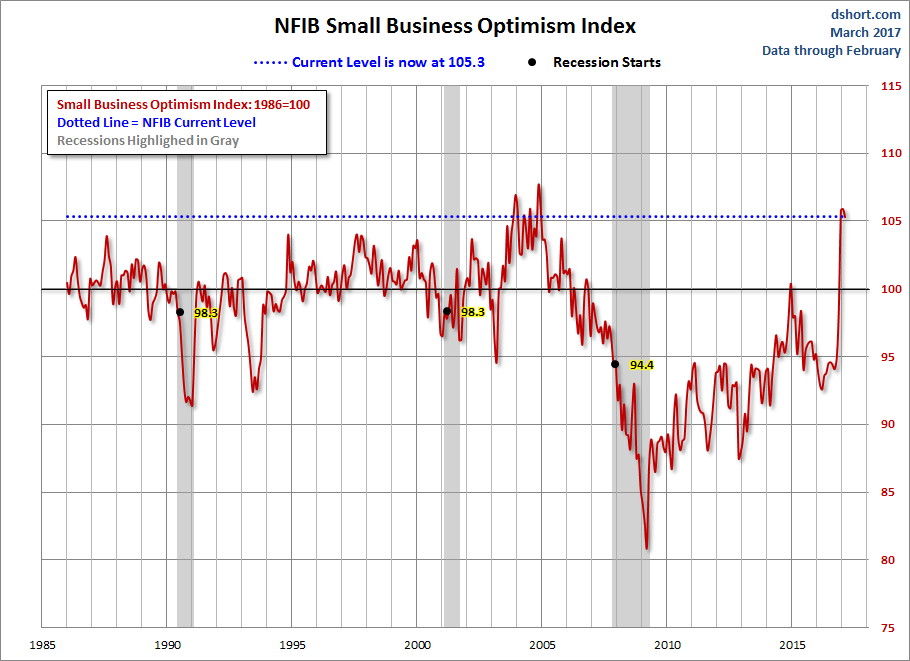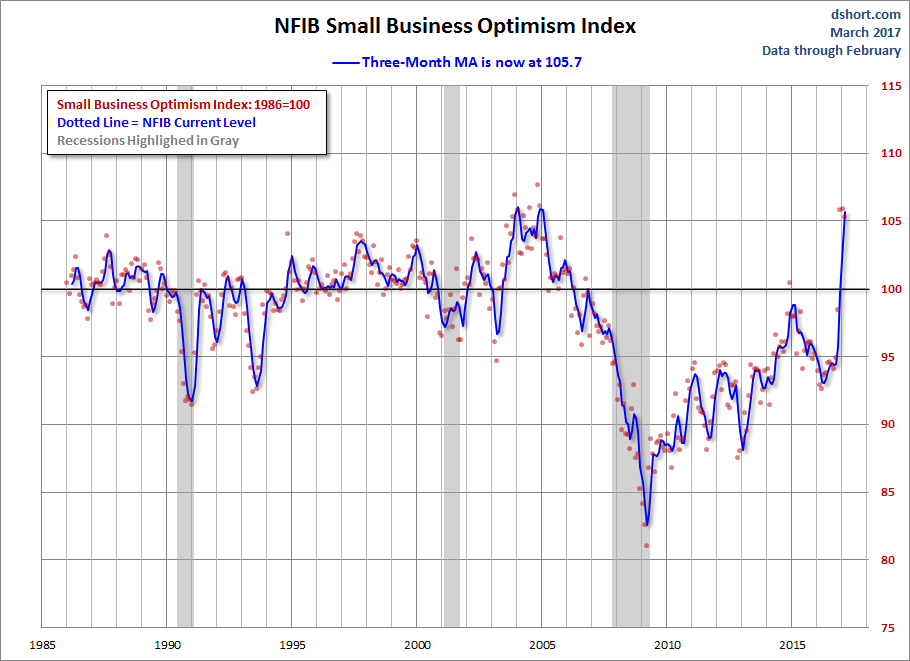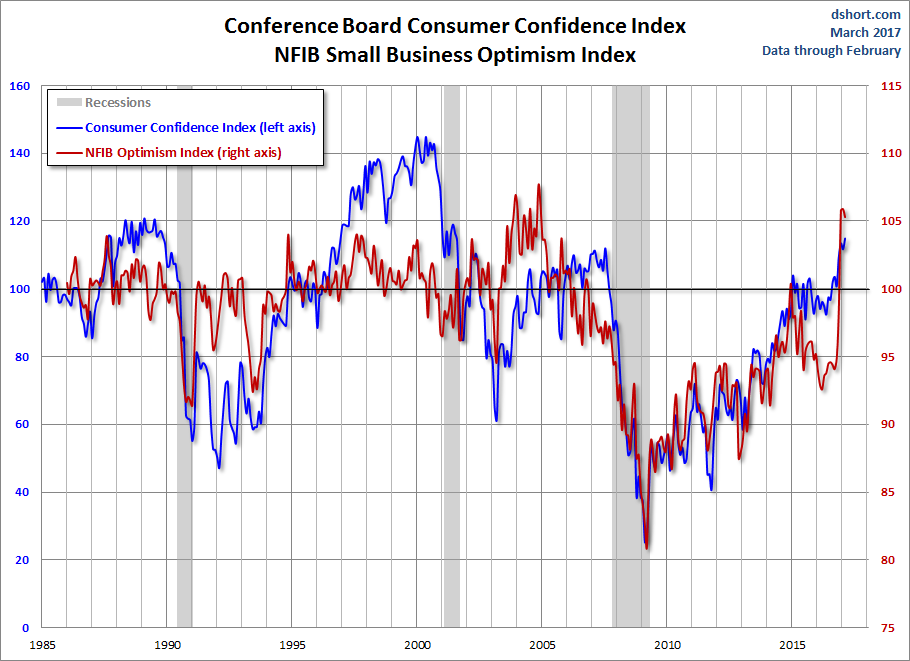The latest issue of the NFIB Small Business Economic Trends came out this morning. The headline number for February came in at 105.3, down 0.6 from the previous month's 105.9, and just under its interim high. The index is at the 98th percentile in this series. Today's number came in below the Investing.com forecast of 106.1.
Here is an excerpt from the opening summary of the news release.
Small business optimism remained at one of its highest readings in 43 years, as small business awaits a new healthcare law, tax reform, and regulatory relief from Washington, according to the February National Federation of Independent Business (NFIB) Small Business Optimism Index, released today.
“It is clear from our data that optimism skyrocketed after the election because small business owners anticipated a change in policy,” said NFIB President and CEO Juanita Duggan. “The sustainability of this surge and whether it will lead to actual economic growth depends on Washington’s ability to deliver on the agenda that small business voted for in November. If the health care and tax policy discussions continue without action, optimism will fade.”
The Index fell 0.6 points in February to 105.3 yet remains a very high reading. The slight decline follows the largest month-over-month increase in the survey’s history in December and another uptick in January. Three of the ten components increased, six declined modestly, and one was unchanged. Despite a small decrease, nearly half of owners expect better business conditions in the coming months.
The first chart below highlights the 1986 baseline level of 100 and includes some labels to help us visualize that dramatic change in small-business sentiment that accompanied the Great Financial Crisis. Compare, for example, the relative resilience of the index during the 2000-2003 collapse of the Tech Bubble with the far weaker readings following the Great Recession that ended in June 2009.

Here is a closer look at the indicator since the turn of the century. We are now just below the post-recession interim high.

The average monthly change in this indicator is 1.3 points. To smooth out the noise of volatility, here is a 3-month moving average of the Optimism Index along with the monthly values, shown as dots.

Here are some excerpts from the report:
Labor Markets
Small business owners reported a seasonally adjusted average employment change per firm of 0.06 workers, just above the zero line but positive. Fourteen percent (up 1 point) reported increasing employment an average of 1.9 workers per firm and 10 percent (unchanged) reported reducing employment an average of 4.8 workers per firm (seasonally adjusted). Fifty-two percent reported hiring or trying to hire (down 1 point), but 44 percent reported few or no qualified applicants for the positions they were trying to fill.
Inflation
How effective has the Fed's monetary policy been in lifting inflation to it two percent target rate?
The net percent of owners raising average selling prices was a net 6 percent (up 1 point). Ten percent of owners reported reducing their average selling prices in the past three months (down 1 point), and 16 percent reported price increases (up 1 point). The frequency of reported price hikes has ticked up since November, but not enough to produce a lot of inflation.
Credit Markets
Has the Fed's zero interest rate policy and quantitative easing had a positive impact on Small Businesses?
Three percent of owners reported that all their borrowing needs were not satisfied, down 1 point. Thirty percent reported all credit needs met (down 1 point), and 52 percent explicitly said they did not want a loan. However, including those who did not answer the question, uninterested in borrowing, 67 percent of owners have no interest in borrowing. Record numbers of firms remain on the “credit sidelines”, seeing no good reason to borrow yet, in spite of the surge in optimism.
NFIB Commentary
This month's "Commentary" section includes the following observations:
Evidence on the economy is mixed, the New York Federal Reserve puts first quarter growth at 3.1 percent while the Atlanta Federal Reserve is looking for 1.8 percent. Both have access to the same data. Growth will make everyone, regardless of politics, feel better. However, the gulf between liberals and conservatives is large. The University of Michigan/Reuters poll in February illustrated this, with the Expectations Index at 55 among Democrats, 120 for Republicans and 89 for Independents. The Democrats expect the worst, the Republicans the best. Spontaneous positive references to economic policy were made by a record 28 percent of consumers, 26 percent made negative references. Reality will resolve the gap.
Business Optimism and Consumer Confidence
The next chart is an overlay of the Business Optimism Index and the Conference Board Consumer Confidence Index. The consumer measure is the more volatile of the two, so it is plotted on a separate axis to give a better comparison of the two series from the common baseline of 100.

These two measures of mood have been highly correlated since the early days of the Great Recession. The two diverged after their previous interim peaks, but have recently resumed their correlation. A decline in Small Business Sentiment was a long leading indicator for the last two recessions.
